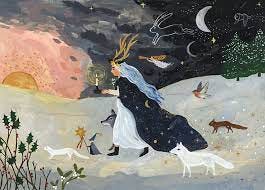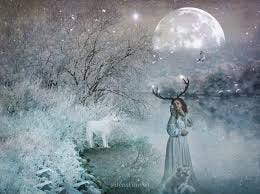Goddesses of the Winter Solstice- Mothers & Bearers of Divine Light
At winter solstice, the sun is born of the womb of darkness.
As we enter the Winter Solstice, we reach the depth of that darkness with the longest night of the year. Darkness is at its peak and we await the return of light. The Earth grows dark and cold as the Sun disappears, the days gradually get shorter. But at Solstice, something magical happens. As the wheel of the year turns, we are able to be guided by and to align with ancient traditions, mythical goddesses, and the enduring significance of this celestial season. This event, occurring around December 21st in the Northern Hemisphere, has been a central celebration in the history of various cultures, each with its unique customs and rituals. The word “solstice” is derived from the Latin words “sol” (sun) and “sistere” (to stand). Winter solstice is also known as “The Day the Sun Stands Still.”
At winter solstice, the sun is born of the womb of darkness. As we move into the depths of the darkness, we too meet with the shadow aspects of ourselves. As we illuminate and integrate the lessons they bring we move forward embodied deeper in our truth.
From the original chaos, the elemental ether, the black void -- The Great Uterine Darkness -- that the old creatrix goddesses are said to have brought forth all that is. As the presence of the black void permeates in all directions. Among the most archaic images of the sun is the brilliant radiance, the flaming aura that clothes the Great Goddess. The great Mother of the pre-Islamic peoples of Southern Arabia was the sun, Atthar, or Al-Ilat (later masculinized to become Allah). In Mesopotamia, She was called Arinna, Queen of Heaven. The Vikings named Her Sol, the old Germanic tribes, Sunna, the Celts, Sul or Sulis. The Goddess Sun was also known among the societies of Siberia, North America and Australia. She is Sun Sister to the Inuit, Sun Woman to the Australian Arunta, Akewa to the Toba of Argentina. The sun has retained its archaic feminine gender in Northern Europe and Arab nations as well as in Japan. To this day, members of the Japanese royal family trace their shining descent to Amaterasu Omikami, the Heaven Illuminating Goddess, and display Her glowing image on their national flag. The journey of the Goddess Inanna into the depths of the Underworld is highly symbolic of our descent into the darkest time the year. Inanna was a Sumerian Goddess of love, fertility and war and Queen of Heaven. She journeys to the Underworld to meet with the shadow side of herself, her sister Erishkigal, and in the process she gives up all that she is taught defines her until she is stripped bear. She is killed and reborn by her shadow self, embodying both the darkness and the light aspects of herself in her resurrection. She shows us the necessity of embodying all the parts of ourselves, and of peeling back the layers and peering into the unseen.
Other cultures see the Goddess not as the sun Herself, but as the mother of the sun. The bringer forth, the protector and controller, the guiding light of the sun and its cycles. According to Maori myth, the sun dies each night and returns to the cave/womb of the deep to bathe in the maternal uterine waters of life from which he is re-born each morning. The Hindu Fire God, Agni, is described as "He who swells in the mother."
It is on the Winter Solstice, the day when the light begins to lengthen and re-gain power that the archetypal Great Mother gave birth to the sun who is Her son. The great Egyptian Mother Goddess, Isis, gave birth to Her son Horus, the Sun God, on the Winter Solstice. On the same day of the year, the Greek goddess Leta gave birth to the bright, shining Apollo; and Demeter, the Great Mother Earth Goddess, bore Dionysus. The shortest day was also the birthday of the Invincible Sun in Rome, Dies Natalis Invictis Solis, as well as that of Mithra, the Persian god of light and guardian against dark evil.
The birth of the archetypal sun, the shining son of The Great Mother on the Winter Solstice brings forth the luminescence from Her dark womb and offers it as a gift of life to the world. This light that retrieves us from the dark of night, the pitch of winter, is a microcosmic recreation of the origin of the universe. The Winter Solstice, then, is an anniversary celebration of creation.
WINTER SOLSTICE GODS AND GODDESSES
During winter solstice, there were also stories about kinder beings, and a variety of gods and goddesses were worshiped, like Tonantzin in Mexico, Cailleach Bheru in Scotland, Horus in Egypt and Spider Grandmother by the Hopi.
Winter solstice has also been known to celebrate Earth’s regeneration or rebirth, and the Scandinavian Goddess, Beiwe, is associated with health and fertility. It was believed that she traveled through the night sky in a structure made of reindeer bones with her daughter, Beiwe-Neia, to bring back the greenery on which the reindeer fed. For this reason she was worshiped during this time of year.
In Italian folklore, La Befana is a goddess who rides around the world on her broom during the solstice, leaving candies and gifts to well-behaved children. Placing a rag doll in her likeness by the front door or window entices her into the home.
Alcyone is the Kingfisher goddess. She nests every winter for two weeks, and while she does, the wild seas become calm and peaceful. Alcyone was one of the seven sisters of the Pleiades.
Frigg, the queen of the Aesir, is linked to the Winter Solstice. Her presence during this time influences the length and severity of winter. She is often depicted with her spindle, symbolizing the spinning of the wheel of the year. As we gather to celebrate the Winter Solstice, we honor Frigg’s role in steering the course of the season. We love adding a drop spindle to an altar when we honor Frigg.
Skadi, the frost giantess, reigns over the winter season and the hunt. Her stories emphasize the formidable aspects of winter, yet she also embodies the enduring spirit of nature’s strength. As we end up in the chill of the Winter Solstice, Skadi reminds us of the primal forces that winter can wield.
Demeter, a Greek goddess. Through her daughter, Persephone, Demeter is linked strongly to the changing of the seasons and is often connected to the image of the Dark Mother in winter. When Persephone was abducted by Hades, Demeter's grief caused the earth to die for six months, until her daughter's return.
The Virgin Mary, the Christian deity of winter, having given birth in a stable at a time we think of as midwinter to Jesus, after still being a virgin is Mary. A mother honored by many in the winter months, as the mother of Jesus Christ.
Cailleach, the enigmatic Winter Hag, embodies the harshest aspects of winter. She brings the cold and snow, a reminder of the trials this season presents. But Cailleach is not merely a bringer of darkness; she is a symbol of transformation. Her ability to turn to stone and back echoes the eternal cycle of life, death, and rebirth. She brings with her gifts of shadow and silence- how to be still and listen.
Brigid, as the Winter Solstice transitions into Imbolc, Brigid takes the stage. Brigid is the goddess of fire, poetry, and healing. She presides over the transition from winter to spring, signifying the return of light, warmth, and life. She awakens the earth in the earliest transition from winter to spring. When we celebrate Brighid during Yule, we honor her transformative power.
Amaterasu (Japanese) In Japanese folklore, Amaterasu, the sun goddess, is aligned with the Winter Solstice. Her retreat into a cave, causing darkness and chaos, mirrors the Winter Solstice’s descent into darkness. Though she was tricked into coming out, her eventual return to the world symbolizes the resurgence of light, warmth, and life.
Spider Woman (Hopi) Soyal is the Hopi festival of the winter solstice. It honors the Spider Woman and the Hawk Maiden, and celebrates the sun's victory over winter's darkness.
The Winter Solstice universally symbolizes hope, rebirth, and the triumph of light over darkness. It is powerful to go out into nature and make a solstice celebration and ceremony. This can be done both alone and with others. The reason why it is rewarding to work with ceremonies and celebration in nature is that the day’s particularly strong energy is best felt by being close to nature and its creatures. You can and also work in a garden or indoors, then feel free to invite the nature creatures into your home. This dark time offers us the perfect fertile soil to plant all that we desire. Here all things can grow and flourish as the light returns once more.
Winter Solstice Affirmation
I release all that no longer serves me I open to the changes that will bring forth my desires I embrace transformation and rebirth I am rooted deeply in my truth I trust in the unseen miracles that flow to me in every breath I open to the abundance and blessings that this new year brings So it is.
May we all have celestial blessings during this incredible time on Earth.
May we rejoice in peace, love and eternal oneness.
As we prepare to exhale that full breath on December 21, Winter Solstice, we are at the place to begin to dream about the coming year and what we would like to create.
Marni
Ref: www.trustgaia.com, www.sacredmother.com, www.themoonschool.com





